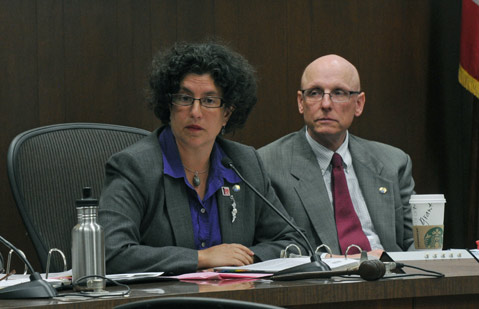Playing Chicken with Freeway Widening
City Hall Pushes for New Cabrillo Bridge

Superficially, it couldn’t have been more ho-hum; Santa Barbara’s City Council approved a $99,000 contract with an out-of-town engineering firm to figure out exactly how much it will cost to build a new and wider railroad bridge over Cabrillo Boulevard to replace the one located by the Andree Clark Bird Refuge that Union Pacific built about 100 years ago. Less obviously, it constituted an oblique declaration that City Hall might throw a massive monkey wrench into Caltrans’s $500 million plans to expand Highway 101 — replete with an HOV (high-occupancy vehicle) lane — from Milpas Street to the county line.
At issue is City Hall’s long-simmering frustration that previous commitments to widen the space under the Cabrillo bridge to accommodate a new sidewalk, bike paths, and at least one additional lane have not been honored. Nowhere in Caltrans’s latest plans is that omission rectified, and Santa Barbara Mayor Helene Schneider is not happy about that. “What we’ve been hearing is, ‘Trust us,’” Schneider said. “But we’re well beyond the ‘Trust us’ stage.” If City Hall doesn’t get a more specific and enforceable commitment, she said, the council or the Planning Commission could vote to withhold the local coastal-development permit the freeway widening needs to go forward. The first issue to be resolved is how much the new bridge would cost to build. Until now, estimates careened between $5 million and $50 million. The second issue is where that money will come from. The engineering contract will resolve the first question; the answer to the second remains highly uncertain.
If the projected freeway widening moves forward without a new Cabrillo bridge, Santa Barbara’s traffic czar Ron Dayton predicted the existing bridge will emerge as a serious congestion pinch point. The new plans call for the installation of a new Cabrillo on-ramp, but without a new bridge to accommodate the additional traffic the on-ramp will generate, motorists could find themselves backed up along Cabrillo the length of a full city block trying to get onto the freeway. Because the new bridge was not technically included as part of the freeway widening’s “project description,” its negative impacts on Cabrillo Boulevard do not have to be ameliorated by the project design.
Making matters worse, this showdown proved to be a bad case of déjà vu around City Hall. The Cabrillo railroad bridge was supposed to have already been widened under the agreement City Hall struck with Caltrans and SBCAG (Santa Barbara County Association of Governments) back in 1998 for the first leg of freeway widening that concluded in 2008. But that deal, it turned out, was not binding on Union Pacific, which objected that the plans to install a tunnel under the bridge might destabilize the tracks above because of soil subsidence. Accordingly, the railroad giant refused to allow the work to happen. It did, however, express a theoretical openness to discussing a new bridge.
Union Pacific enjoys a reputation as an extremely hard bargainer. To help navigate the sometimes impenetrable world of Union Pacific, City Hall hired a consulting firm made up of former Union Pacific engineers. Whether the work winds up costing $5 million, $50 million, or somewhere in between, the toughest question remains: Where will the funding come from? SBCAG’s Gregg Hart — who is running for the Santa Barbara City Council — cautioned that the funds are extremely finite. City Hall representatives, he noted, were appealing to SBCAG for road-repair funds late last week. If money is spent on the bridge, he warned, there will be less to spend on road repairs.
City Hall officials are confident that costs can be dramatically minimized if Union Pacific itself builds the new bridge. By reputation, the railroad company is extremely fast and efficient when it comes to infrastructure construction. Beyond that, city officials noted there’s already a funding shortfall for the new freeway-widening work to the tune of $70 million. If that’s the case, they reason, what’s a few million more?



